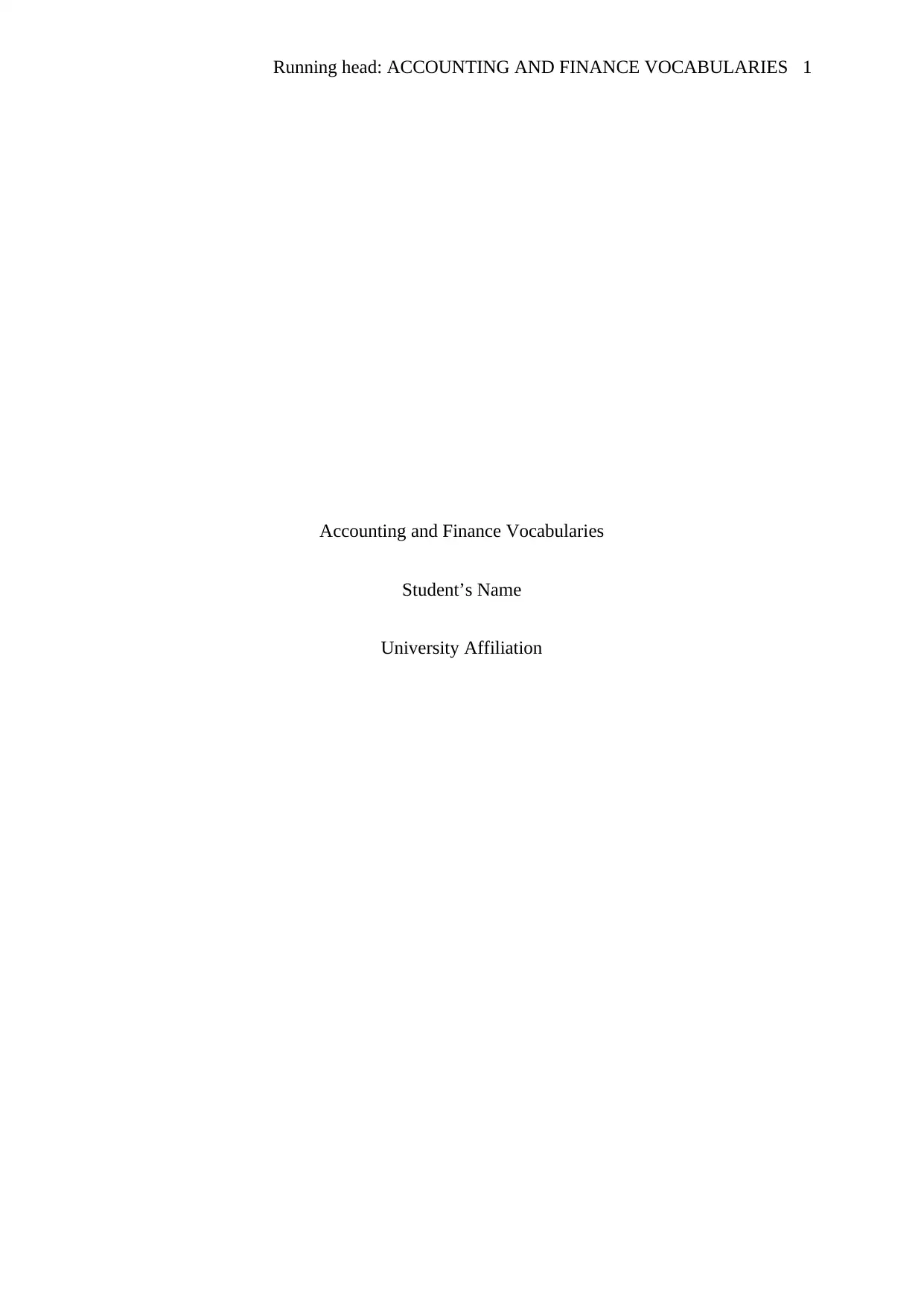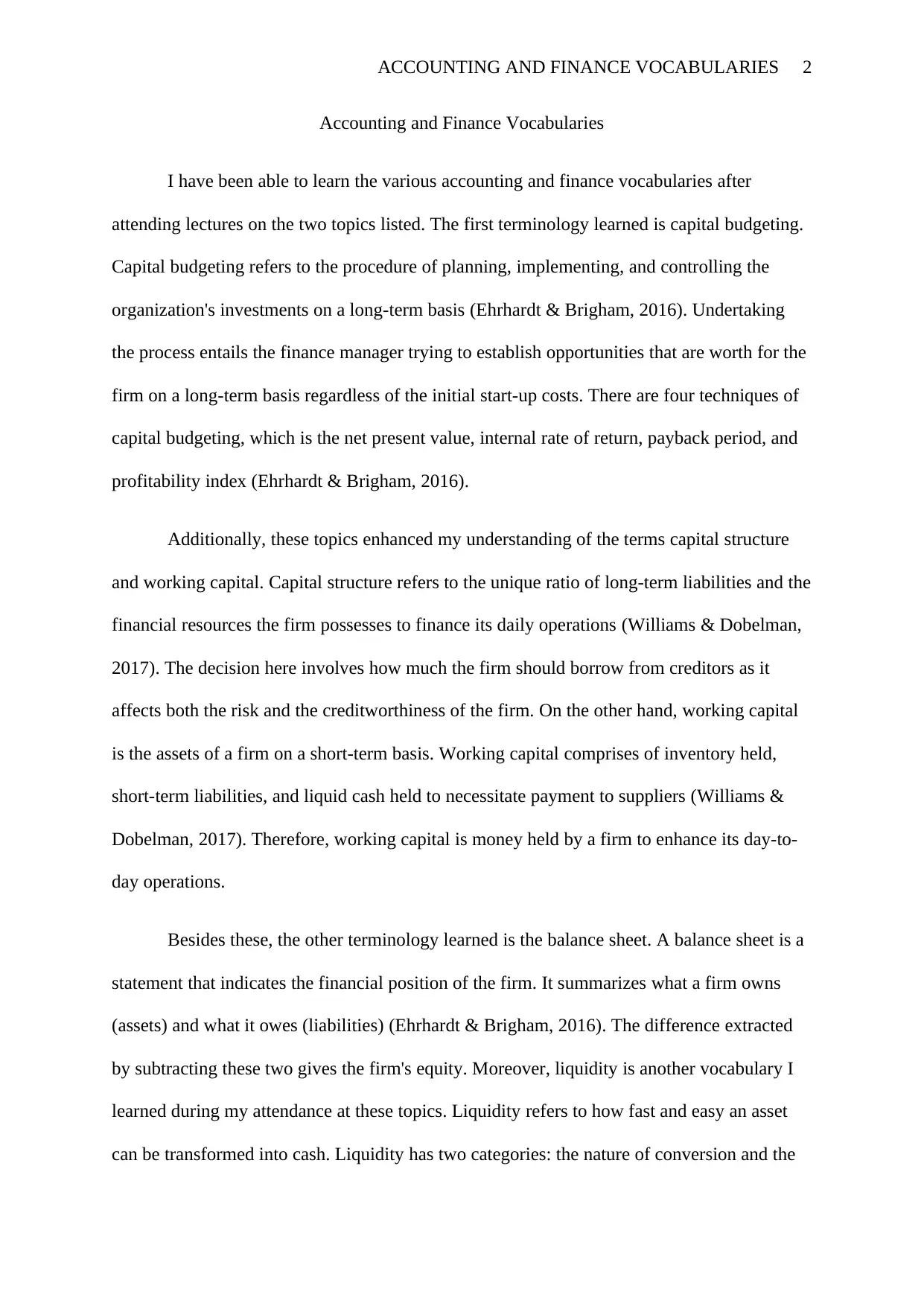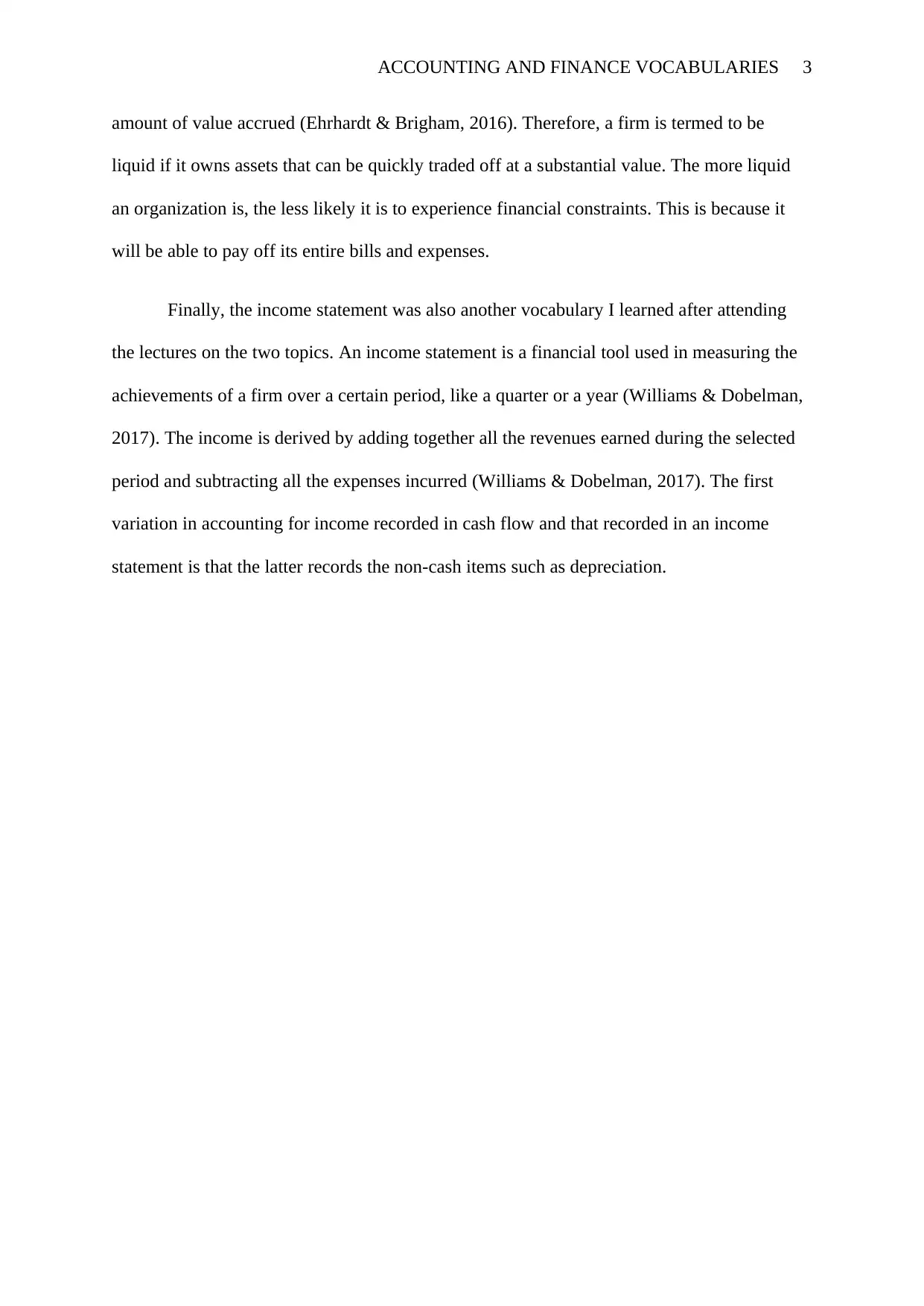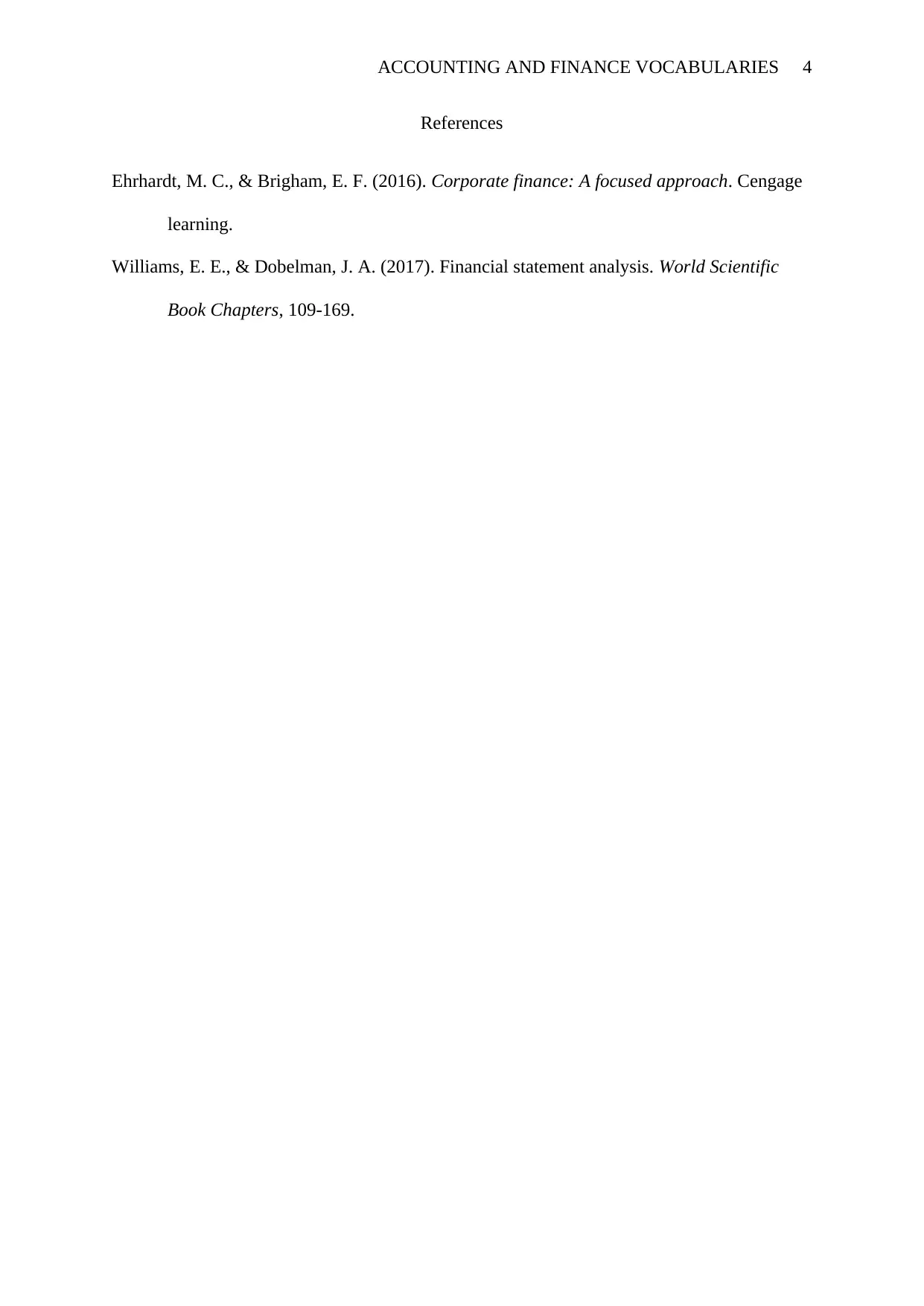Accounting and Finance Vocabularies: Analysis of Key Terminology
VerifiedAdded on 2022/08/24
|4
|618
|40
Homework Assignment
AI Summary
This assignment provides a student's understanding of core accounting and finance vocabularies. The student defines and explains terms such as capital budgeting, capital structure, and working capital. The assignment also covers the balance sheet, liquidity, and the income statement, highlighting their significance in financial analysis. The student emphasizes the importance of these terms in understanding a firm's financial position and performance. The assignment concludes with a reference list of sources used to support the information.

Running head: ACCOUNTING AND FINANCE VOCABULARIES 1
Accounting and Finance Vocabularies
Student’s Name
University Affiliation
Accounting and Finance Vocabularies
Student’s Name
University Affiliation
Paraphrase This Document
Need a fresh take? Get an instant paraphrase of this document with our AI Paraphraser

ACCOUNTING AND FINANCE VOCABULARIES 2
Accounting and Finance Vocabularies
I have been able to learn the various accounting and finance vocabularies after
attending lectures on the two topics listed. The first terminology learned is capital budgeting.
Capital budgeting refers to the procedure of planning, implementing, and controlling the
organization's investments on a long-term basis (Ehrhardt & Brigham, 2016). Undertaking
the process entails the finance manager trying to establish opportunities that are worth for the
firm on a long-term basis regardless of the initial start-up costs. There are four techniques of
capital budgeting, which is the net present value, internal rate of return, payback period, and
profitability index (Ehrhardt & Brigham, 2016).
Additionally, these topics enhanced my understanding of the terms capital structure
and working capital. Capital structure refers to the unique ratio of long-term liabilities and the
financial resources the firm possesses to finance its daily operations (Williams & Dobelman,
2017). The decision here involves how much the firm should borrow from creditors as it
affects both the risk and the creditworthiness of the firm. On the other hand, working capital
is the assets of a firm on a short-term basis. Working capital comprises of inventory held,
short-term liabilities, and liquid cash held to necessitate payment to suppliers (Williams &
Dobelman, 2017). Therefore, working capital is money held by a firm to enhance its day-to-
day operations.
Besides these, the other terminology learned is the balance sheet. A balance sheet is a
statement that indicates the financial position of the firm. It summarizes what a firm owns
(assets) and what it owes (liabilities) (Ehrhardt & Brigham, 2016). The difference extracted
by subtracting these two gives the firm's equity. Moreover, liquidity is another vocabulary I
learned during my attendance at these topics. Liquidity refers to how fast and easy an asset
can be transformed into cash. Liquidity has two categories: the nature of conversion and the
Accounting and Finance Vocabularies
I have been able to learn the various accounting and finance vocabularies after
attending lectures on the two topics listed. The first terminology learned is capital budgeting.
Capital budgeting refers to the procedure of planning, implementing, and controlling the
organization's investments on a long-term basis (Ehrhardt & Brigham, 2016). Undertaking
the process entails the finance manager trying to establish opportunities that are worth for the
firm on a long-term basis regardless of the initial start-up costs. There are four techniques of
capital budgeting, which is the net present value, internal rate of return, payback period, and
profitability index (Ehrhardt & Brigham, 2016).
Additionally, these topics enhanced my understanding of the terms capital structure
and working capital. Capital structure refers to the unique ratio of long-term liabilities and the
financial resources the firm possesses to finance its daily operations (Williams & Dobelman,
2017). The decision here involves how much the firm should borrow from creditors as it
affects both the risk and the creditworthiness of the firm. On the other hand, working capital
is the assets of a firm on a short-term basis. Working capital comprises of inventory held,
short-term liabilities, and liquid cash held to necessitate payment to suppliers (Williams &
Dobelman, 2017). Therefore, working capital is money held by a firm to enhance its day-to-
day operations.
Besides these, the other terminology learned is the balance sheet. A balance sheet is a
statement that indicates the financial position of the firm. It summarizes what a firm owns
(assets) and what it owes (liabilities) (Ehrhardt & Brigham, 2016). The difference extracted
by subtracting these two gives the firm's equity. Moreover, liquidity is another vocabulary I
learned during my attendance at these topics. Liquidity refers to how fast and easy an asset
can be transformed into cash. Liquidity has two categories: the nature of conversion and the

ACCOUNTING AND FINANCE VOCABULARIES 3
amount of value accrued (Ehrhardt & Brigham, 2016). Therefore, a firm is termed to be
liquid if it owns assets that can be quickly traded off at a substantial value. The more liquid
an organization is, the less likely it is to experience financial constraints. This is because it
will be able to pay off its entire bills and expenses.
Finally, the income statement was also another vocabulary I learned after attending
the lectures on the two topics. An income statement is a financial tool used in measuring the
achievements of a firm over a certain period, like a quarter or a year (Williams & Dobelman,
2017). The income is derived by adding together all the revenues earned during the selected
period and subtracting all the expenses incurred (Williams & Dobelman, 2017). The first
variation in accounting for income recorded in cash flow and that recorded in an income
statement is that the latter records the non-cash items such as depreciation.
amount of value accrued (Ehrhardt & Brigham, 2016). Therefore, a firm is termed to be
liquid if it owns assets that can be quickly traded off at a substantial value. The more liquid
an organization is, the less likely it is to experience financial constraints. This is because it
will be able to pay off its entire bills and expenses.
Finally, the income statement was also another vocabulary I learned after attending
the lectures on the two topics. An income statement is a financial tool used in measuring the
achievements of a firm over a certain period, like a quarter or a year (Williams & Dobelman,
2017). The income is derived by adding together all the revenues earned during the selected
period and subtracting all the expenses incurred (Williams & Dobelman, 2017). The first
variation in accounting for income recorded in cash flow and that recorded in an income
statement is that the latter records the non-cash items such as depreciation.
⊘ This is a preview!⊘
Do you want full access?
Subscribe today to unlock all pages.

Trusted by 1+ million students worldwide

ACCOUNTING AND FINANCE VOCABULARIES 4
References
Ehrhardt, M. C., & Brigham, E. F. (2016). Corporate finance: A focused approach. Cengage
learning.
Williams, E. E., & Dobelman, J. A. (2017). Financial statement analysis. World Scientific
Book Chapters, 109-169.
References
Ehrhardt, M. C., & Brigham, E. F. (2016). Corporate finance: A focused approach. Cengage
learning.
Williams, E. E., & Dobelman, J. A. (2017). Financial statement analysis. World Scientific
Book Chapters, 109-169.
1 out of 4
Related Documents
Your All-in-One AI-Powered Toolkit for Academic Success.
+13062052269
info@desklib.com
Available 24*7 on WhatsApp / Email
![[object Object]](/_next/static/media/star-bottom.7253800d.svg)
Unlock your academic potential
Copyright © 2020–2025 A2Z Services. All Rights Reserved. Developed and managed by ZUCOL.




